Summary of the forms of diamond cuts
The term brilliant is today so closely associated With the mineral diamond that people often speak of "brilliant" when they mean the mineral diamond.
The brilliant is the "classic" among all cut forms. Its designation applies exclusively to the circular form of cut which exhibits at least 32 facets and a table on the crown, and at least 24 facets and a culet on the pavilion.
The description diamond assumes the genuineness of the stone.
The facets are described as follows (Fig 191):
| on the crown | 8 table facets |
| 8 upper main facets | |
| 16 upper girdle facets | |
| on the pavilion | 8 lower main facets |
| 16 lower girdle facets |
Simplified varieties of the brilliant cut are
-
the eight-cut, also called Single-cut, with 8 facets each on the crown and pavilion (Fig 192);
-
the sixteen-cut, also called Swiss-cut, with 16 facets on both the crown and the pavilion (Fig 192).
Among the modified brilliant cuts are (Fig 192):
-
the Navette or Marquise
-
the Pear or Pendelaque
-
the Oval and
-
the Heart cut.
The number and arrangement of the facets is in general
Similar to the brilliant cut, but occasionally the number and
arrangement of the pavilion facets vary
(Fig 193). The present day step cuts have developed from one of the
earliest styles of diamond cut, the table stone; they are:
-
the Emerald cut
-
rectangular or square-shaped
-
the Baguette. Square and Trapeze cut (Fig193).
Fig 191 The Facets of a Brilliant

| Fig 192 Forms of Diamond Cuts | |
 |
 |
| Eight-cut | Swiss-cut |
| Modified Brilliants | ||
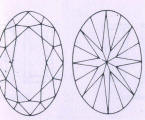 |
 |
 |
| Oval-cut | Navette or Marquise | Drop Pendeloque or Pear |
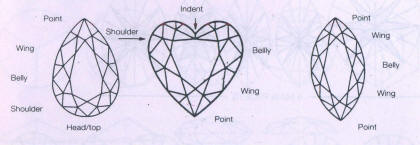
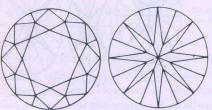 |
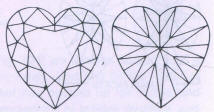 |
| Brilliant | Heart-shape |
| Fig 193 Various arrangements of the pavilion facets in modified brilliant cuts | |
 |
 |
| 9 MAIN FACETS | 8 MAIN FACETS |
 |
|
| 7 MAIN FACETS | |
 |
|
| 6 MAIN FACETS | |
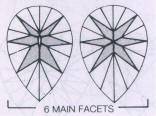 |
 |
| 6 MAIN FACETS | 4 MAIN FACETS |
| Fig 194 Forms of Diamond Cuts | |||||||
 |
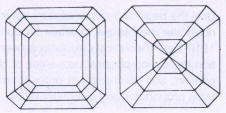 |
||||||
| Emerald cut, rectangular | Emerald cut, square | ||||||
 |
 |
 |
|
||||
| Baguette | Trapeze | Square | |||||
 |
 |
 |
 |
 |
|||
| 3-facet rose | 6-facet rose | Double Dutch Rose | Simple Dutch Rose | Antwerp Rose | |||
The various forms of diamond Roses (Fig 194) are likewise derived from a historical type of cut. Today they are only rarely used and for the repair of antique jewelry. However a new market has opened up for Roses and antique. cuts with the manufacture of reproductions of antique jewelry, and diamonds are being specially cut for these according to old models.
| Scan D.N. | Types of Brilliant Cut |